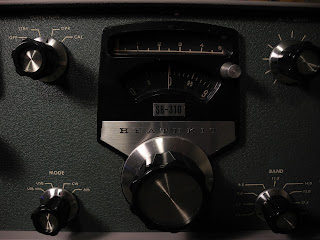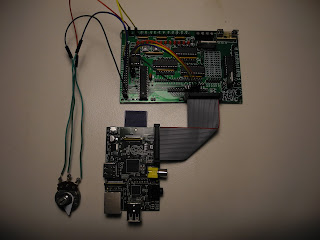I love building electronic kits, and there is a long tradition of kit building among people who tinker with electronics, including amateur radio operators, that goes back almost 100 years.
That tradition continues today with products like the replica computers offered by
Briel Computers and amateur radio kits from companies like
Elecraft.
Despite predictions that surface mount technology and the reduced emphasis on electricity and electronics in education would mean the demise of kits, the popularity of kit building has grown in the last ten years or so, as part of what is now often called the "maker" movement.
While kits have differing levels of complexity in terms of the number of parts involved and effort to assemble them, it seems to me that there are four fundamentally different levels of kit building.
Let me expound my theory, which I think is original if not particularly insightful.
Level 1: Assembling From Pre-built Components or Modules.
Kits at this level involve assembling pre-built components and mechanically connecting pieces together but doesn't involve any soldering, or if it does, just simple soldering of wires and connectors.
I've heard people talk about "building their own computer" and more often than not they mean building one at this level -- taking a commercial motherboard, case, and power supply, and connecting them together into a working computer.
Examples of this category include the pre-assembled Apple Replica 1, the Arduino embedded controller or the Elecraft K3 amateur radio transceiver.
 |
| An Arduino Embedded Controller |
This can be a good way to get started in electronics and build up confidence before you are ready to pick up a soldering iron.
Level 2: Building a Commercial Kit
The next level involves assembly of a kit that requires soldering as well as mechanical assembly. You need to be able to solder competently and identify electronic components. You don't need to understand the circuit being built and don't need expensive test equipment although a Digital Multi Meter (DMM) is very useful.
The kit may include a professional case, power supply, etc. or may leave it up to the user to provide these.
The Heathkit company was the premiere source of kits of this type for many years and was renowned for the quality of its manuals and the professional look of the kits when assembled.
Briel Computers and many other companies offer similar kits of this type.
 |
| An Assortment of Heathkit Equipment |
Level 3: Building From a Provided Design
The next step up is to take an electronic design, such as one described in a magazine or book article, or possibly as little as a schematic diagram, and realizing it as working device.
This involves finding and sourcing all the components, figuring out how to lay out the parts and deciding what construction technique to use (such as simple point to point wiring, a printed circuit board, or others such as "ugly" construction style).
This level offers more risks and challenges. There may be hidden gotchas in the design that will depend on the parts used or how it is assembled. There make even be errors in the design.
The builder needs to understand the circuit although not how all component values were determined. You may need more extensive test equipment such as an oscilloscope, signal generators, etc. in order to test and debug it. You may need tune or calibrate the circuit for proper operation.
This was how a lot of equipment was built by radio amateurs in the old days and still today. Circuits were often published in books like the Radio Amateur's Handbook or periodicals like QST magazine.
It is very rewarding as the end result is unique and there are often opportunities for making modifications.
An example from amateur radio is a transceiver (transmitter and receiver) called the the
Ugly Weekender that was published in the amateur radio magazine QST in the 1980s. I built this unit using "ugly" construction on a bare copper board and built it into a case.
 |
| My Version of The Ugly Weekender |
Level 4: Building Your Own Design
This is the ultimate level where you are no longer building a kit, but your own design.
You design the circuit yourself (possibly based on some existing design) and assemble it. To be successful you need to fully understand the circuit. You may even want to simulate the design using circuit simulation tools, or at least prototype key portions of it to verify the design.
This level of project can take months or more depending on the complexity and the time available to spend on it. It is the most risky but also the most rewarding if successful. If you succeed at this you've reached the "black belt" level.
A small example could be the RAM/EEPROM card I designed and built for the Apple Replica 1.
 |
| Replica 1 RAM/EEPROM Card |
In summary, kit building can be categorized into the four levels I outlined. In practice there is often a grey area between the levels.
So the next time you work on a kit or electronic project, maybe you will ponder at what level you are and maybe consider moving your kit building prowess up to the next level.














































